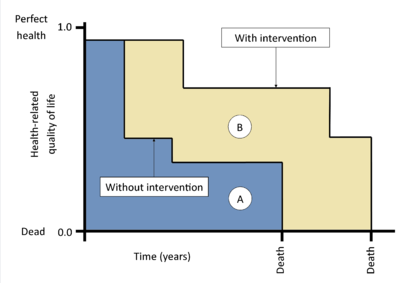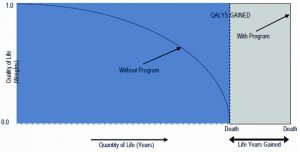
- QALY, commonly known as Quality Adjusted Life Years is a metric which measures the healthy years lived by an individual
- QALY used as a measure for analyzing cost effectiveness of health programs.
- It is one of the widely used measures of health improvement which is mainly used for making resource allocation decisions
- The QALY score of 1 represents perfect health while 0 represents poor health status of an individual
- It is a standard measure of disease burden that jointly looks at quality of life (morbidity) and survival (mortality) i.e. QALY is one of the health indicator which looks at both quantity and quality of life. Because of this feature, QALY provides an estimation of the amount of quality time experienced by an individual due to any health interventions/programs
- QALY is also known as a metric which is used by the health economists and other health professionals to assess new and innovative health care interventions/treatments

- QALY provides guideline for standard measurement of health outcomes which further enables to compare the interventions across different diseases and population groups
- Some of the instruments that can be used for measuring quality adjusted health are: EQ-5D, Health Utility Index, Quality of well-being etc.
- The basic idea of QALY is that : it assumes that one year of life lived in a perfect health is equals to 1 QALY while one year of life lived in less than perfect health equals to less than 1 QALY
- Thus, the formula for calculating QALY is:
- QALY= Years of life*Utility Value
- Example:
- If an individual has perfect health for one year, that person will have 1 QALY. (1 Year of Life × 1 Utility Value = 1 QALY)
- If an individual lives in perfect health but only for half a year, that person will have 0.5 QALYs. (0.5 Years of Life x 1 Utility Value = 0.5 QALYs)
- Likewise, if an individual lives for 1 year in a situation with 0.5 utility (half of perfect health), that person will also have 0.5 QALYs. (1 Year of Life x 0.5 Utility Value = 0.5 QALYs)
Uses of QALY
- To know the effectiveness of one health programs or treatment over the other
- To make final decisions regarding health resource allocation for different interventions
- To evaluate the cost effectiveness of any programs/drugs i.e. how much a program/drugs costs per QALY
- To know the burden of disease in a combined way from psycho-social and biomedical point of views
Limitations of QALY
- Less use of the concept in fields outside health. Also, does not acknowledge non health related outcomes like benefits at the family and society level, back to work etc.
- Does not consider situational differences between or among the individuals and hence looks at all QALY’s in an equal way i.e. overly utilitarian
- Does not encourage health interventions with high initial costs but long term benefits (eg: regenerative medicines)
- It undermines the effectiveness of preventive measures as the impact of preventive measures on health outcomes may not be seen immediately.
References
https://www.ncbi.nlm.nih.gov/pmc/articles/PMC317370/
https://academic.oup.com/heapol/article/21/5/402/578296/Calculating-QALYs-comparing-QALY-and-DALY
https://www.ispor.org/meetings/Invitational/QALY/Paper2revised.PDF
http://www.medicinenet.com/script/main/art.asp?articlekey=5167
http://www.med.uottawa.ca/sim/data/qalys_e.htm
https://link.springer.com/referenceworkentry/10.1007%2F978-1-4419-1005-9_613
https://www.nice.org.uk/glossary?letter=q
http://www.physio-pedia.com/Quality-Adjusted_Life_Year
http://www.celforpharma.com/insight/do-you-know-what-qaly-and-how-calculate-it
http://stroke.ahajournals.org/content/41/4/739
http://www.nejm.org/doi/full/10.1056/NEJMp1405158#t=article
http://www.yhec.co.uk/glossary/quality-adjusted-life-year-qaly/
http://retinatoday.com/2016/03/quality-adjusted-life-years-for-the-retina-specialist/
http://www.oxfordreference.com/view/10.1093/acref/9780199211777.001.0001/acref-9780199211777-e-7626
http://www.who.int/quantifying_ehimpacts/publications/en/9241546204chap3.pdf